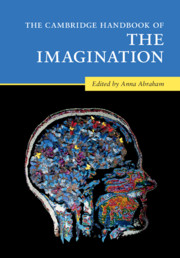Book contents
- The Cambridge Handbook of the Imagination
- The Cambridge Handbook of the Imagination
- Copyright page
- Dedication
- Contents
- Figures
- Contributors
- Acknowledgments
- 1 Surveying the Imagination Landscape
- Part I Theoretical Perspectives on the Imagination
- Part II Imagery-Based Forms of the Imagination
- Part III Intentionality-Based Forms of the Imagination
- Part IV Novel Combinatorial Forms of the Imagination
- Part V Phenomenology-Based Forms of the Imagination
- Part VI Altered States of the Imagination
- 40 Dreaming: Beyond Imagination and Perception
- 41 Dreaming is Imagination Roaming Freely, Based On Embodied Simulation, and Subserved by an Unconstrained Default Network
- 42 Aphantasia
- 43 Hypnosis and Imagination
- 44 Hallucinations and Imagination
- 45 The Psychiatry of Imagination
- 46 Meditation and Imagination
- 47 Flow in Performance and Creative Cognition – An Optimal State of Task-Based Adaptation
- 48 The Force of the Imagination
- Name Index
- Subject Index
- References
41 - Dreaming is Imagination Roaming Freely, Based On Embodied Simulation, and Subserved by an Unconstrained Default Network
from Part VI - Altered States of the Imagination
Published online by Cambridge University Press: 26 May 2020
- The Cambridge Handbook of the Imagination
- The Cambridge Handbook of the Imagination
- Copyright page
- Dedication
- Contents
- Figures
- Contributors
- Acknowledgments
- 1 Surveying the Imagination Landscape
- Part I Theoretical Perspectives on the Imagination
- Part II Imagery-Based Forms of the Imagination
- Part III Intentionality-Based Forms of the Imagination
- Part IV Novel Combinatorial Forms of the Imagination
- Part V Phenomenology-Based Forms of the Imagination
- Part VI Altered States of the Imagination
- 40 Dreaming: Beyond Imagination and Perception
- 41 Dreaming is Imagination Roaming Freely, Based On Embodied Simulation, and Subserved by an Unconstrained Default Network
- 42 Aphantasia
- 43 Hypnosis and Imagination
- 44 Hallucinations and Imagination
- 45 The Psychiatry of Imagination
- 46 Meditation and Imagination
- 47 Flow in Performance and Creative Cognition – An Optimal State of Task-Based Adaptation
- 48 The Force of the Imagination
- Name Index
- Subject Index
- References
Summary
Dreaming is a form of imagination, based on embodied simulation. Dreams frequently involve enactments of a dreamer’s personal conceptions and concerns, both positive and negative, in relation to known persons and favorite avocations. More generally, most dreams include social interactions and activities. Dreaming is supported by an unconstrained portion of the default network, including its dorsal medial and temporal lobe functional subsystems, along with a region in the secondary visual cortex and by the caudate nucleus. The fact that this portion of the default network is unconstrained by the frontoparietal and the dorsal attentional control networks gives dreaming its unique character as imagination roaming freely. This neural substrate has cognitive insufficiencies that are consistent with what is known about dreaming and dream content from six decades of systematic research in laboratory and non-laboratory settings, such as a dearth of episodic memories and only rare indications of “symbolic” content. Nevertheless, there are lawful aspects of dreaming, such as the “small-world” nature of its character networks and consistency in dream content over many years.
Keywords
- Type
- Chapter
- Information
- The Cambridge Handbook of the Imagination , pp. 676 - 691Publisher: Cambridge University PressPrint publication year: 2020
References
- 2
- Cited by



